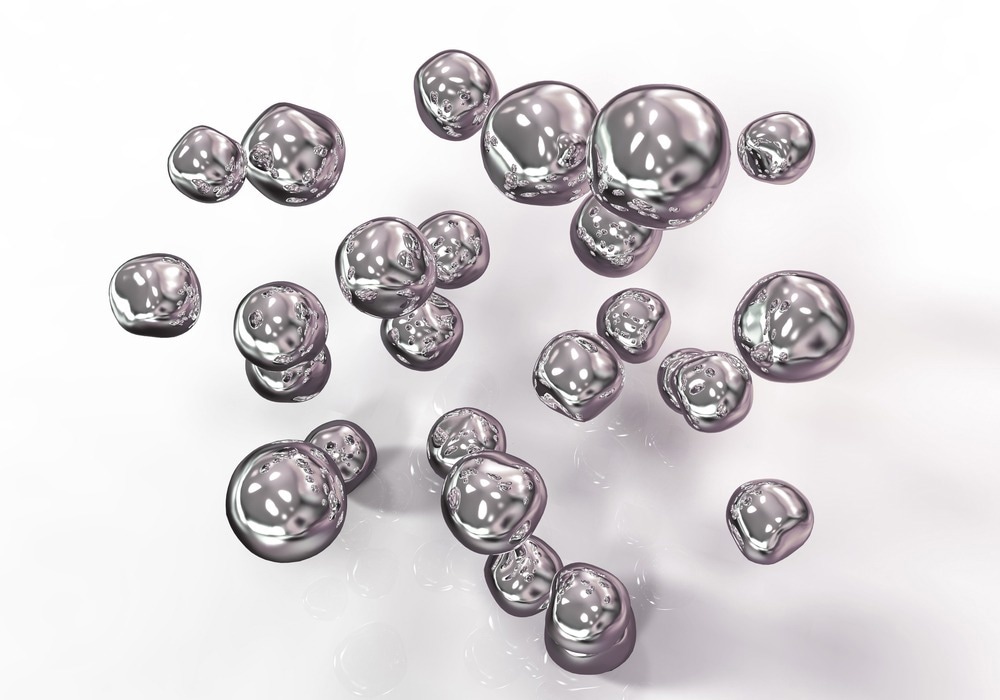A polymer-infiltrated ceramic network (PICN) is a hybrid material comprising polymers and ceramics. Three-dimensional (3D) printing of such materials is one of the fastest evolving aspects of modern prosthodontics because it combines the positive characteristics of both ceramics and polymers.

Study: 3D-Printed Polymer-Infiltrated Ceramic Network with Antibacterial Biobased Silver Nanoparticles. Image Credit: Kateryna Kon/Shutterstock.com
To improve the biomedical applications of PICN, an article published in the journal ACS Applied Biomaterials aimed to functionalize 3D-printed PICN with antimicrobial properties by coating this 3D-printed hybrid material with clinically safe and environmentally benign silver nanoparticles.
In this study, the encapsulation of silver nanoparticles in an enzymatically phenolated lignin matrix led to the fabrication of phenolated lignin-based silver nanoparticles that were subsequently formulated in a 3-(trimethoxysilyl)- propyl methacrylate solution (γ-MPS) and deposited on the PICN surface.
PICN samples functionalized with silver nanoparticles showed activity against gram-negative (Pseudomonas aeruginosa) and gram-positive (Staphylococcus aureus) bacteria with antibacterial efficiency in 24 hours.
Compared to the pristine PICN surface, the PICN scaffold functionalized with silver nanoparticles showed 90% inhibition of Staphylococcus aureus growth. Furthermore, using silver nanoparticle-decorated PICN against keratinocyte (HaCaT) and human fibroblast (BJ-5ta) cell lines validated its biosafety with more than 80% biocompatibility.
Silver Nanoparticles for Biomedical Applications
3D-printed materials are high-quality products produced via a fast and facile 3D printing technique. Moreover, the CAD/CAM processes of 3D printing primarily help in controlling the distribution and size of pores based on the target application, which is otherwise not supported by conventional sintering methods.
PICN materials possess dual structures related to ceramics, long-lasting aesthetics, and polymers. The biocompatibility of this hybrid material promoted the growth and multiplication of osteoblast cells (MG-63) on their surfaces.
While the natural makeup of teeth has inspired the development of PICN materials, incorporating polyacrylate adhesives into macroporous 3D-printed ceramic materials was anticipated to increase the implant's lifespan because the polymer adhesive cures the ceramic material's brittleness.
Although PICN does not promote bacterial growth, modifying it with antibacterial properties is desirable for biomedical applications to avoid biofilm development. Human health is continuously at risk due to the presence of multidrug-resistant bacteria, which are the primary cause of hospital-acquired infections.
Silver nanoparticles can penetrate bacterial cell walls and change the structure of cell membranes, ultimately leading to cell death. The efficacy of silver nanoparticles is not only due to their nanoscale size but also to their large surface-area-to-volume ratio. They can increase the permeability of cell membranes, produce reactive oxygen species (ROS), and interrupt DNA replication by releasing silver ions.
In addition, silver nanoparticles can kill bacteria. Silver nanoparticles can accumulate in the pits formed on the cell wall after they anchor to the bacterial cell surface.
Accumulated silver nanoparticles can cause denaturation of the cell membrane. Silver nanoparticles also can penetrate bacterial cell walls and subsequently change the structure of the cell membrane because of their nanoscale size.
3D-Printed PICN with Antibacterial Biobased Silver Nanoparticles
The endosseous implants, dentures, teeth, and non-shedding surfaces of crowns promote the growth of thick biofilms. Previous studies on methacrylate copolymer-modified zirconia surfaces have mentioned the dip-coating-based adsorption of antimicrobial nanoparticles as an ineffective strategy. This inefficiency was attributed to the high surface tension of the methacrylate copolymer adhered to the zirconia surface.
The team behind this study proposed that deposition of phenolated lignin-based silver nanoparticles on 3D-printed PICN scaffolds could impart antimicrobial activity to the latter, enabling their facile application in prosthodontics.
Here, the PICN samples were activated with phenolated lignin-based silver nanoparticles via chemical etching and by using promoters that facilitated silane solution (γ-MPS) adhesion. Thus, combining phenolated lignin-based silver nanoparticles with γ-MPS resolved the difficulty of attaching the former to the PICN surface.
Furthermore, incubating the silver nanoparticle-decorated PICN surfaces with gram-negative (Pseudomonas aeruginosa) and gram-positive (Staphylococcus aureus) bacteria for 24 hours reduced their growth, indicating the stabilization of the silver nanoparticles on the 3D-printed PICN architecture.
On the other hand, the bactericidal activity of the silver nanoparticles modified PICN surface against HaCaT or BJ-5ta cell lines demonstrated that these nanoparticles prevented bacterial adhesion to PICN surfaces without negatively impacting the human cell lines.
Future Prospects
In this study, the PICN surfaces were functionalized with silver nanoparticles to incorporate antimicrobial ability into these materials and facilitate their biomedical application. The prepared phenolated lignin-based silver nanoparticles modified PICN surfaces showed antimicrobial activity against both gram-positive and gram-negative bacteria and were biocompatible with human cell lines.
Since biomedical implants require longer stability than assayed, the authors aim to validate the lab-proof results of the present work in future antimicrobial studies on phenolated lignin-based silver nanoparticles modified PICN scaffolds using long-term bacteria incubation.
Reference
Hodásová, L et al. (2022) 3D-Printed Polymer-Infiltrated Ceramic Network with Antibacterial Biobased Silver Nanoparticles. ACS Applied Biomaterials. https://pubs.acs.org/doi/10.1021/acsabm.2c00509
Disclaimer: The views expressed here are those of the author expressed in their private capacity and do not necessarily represent the views of AZoM.com Limited T/A AZoNetwork the owner and operator of this website. This disclaimer forms part of the Terms and conditions of use of this website.